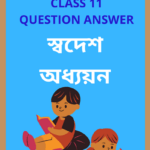Class 11 Swadesh Adhyayan Chapter 3 Resources, Class 11 Question Answer to each chapter is provided in the list of AHSEC so that you can easily browse through different chapters and select needs one. Class 11 Swadesh Adhyayan Chapter 3 Resources Question Answer can be of great value to excel in the examination.
Class 11 Swadesh Adhyayan Chapter 3 Resources Notes covers all the exercise questions in HS 1st Year Swadesh Adhyayan Textbooks Solutions. Assam Board Class 11 Swadesh Adhyayan Chapter 3 Resources provided here ensures a smooth and easy understanding of all the concepts. Understand the concepts behind every chapter and score well in the board exams.
Resources
Chapter – 3
SWADESH ADHYAYAN
1. (a) Quinine is an anti malarial drug is extracted from which flora?
Ans. Cinchona plant.
(b) What is biotic resource?
Ans. Resources which are living or have life and death,consume food grow naturally are category seed under biotic or living resources. These resources are plants, animals, birds fish and marine organisms.
(c) How many National Parks are there in Assam?
Ans. There are five National Park in Assam.
(i) Kaziranga.
(b) Manas.
(c) Nameri.
(d) Orang.
(e) Dibru- Saikhowa.
(d) How many wildlife sanctuaries are there in Assam?
Ans. There are 18 wildlife sanctuaries are there in Assam.
(i) Karbi Anglong.
(ii) Morat Longrie.
(iii) Sonai- Rupai.
(iv) Deeper Beel.
(v) Dibru- Saikhowa.
(vi) Pobitora etc.
(e) What is exhaustible resource ?
Ans. All the abiotic resource found in natural gas non- renewable or exhaustible continuous use of these resources are result in the depletion of this.
(f) What is a Resource?
Ans. Anything available in nature or artificially produced and utilised by man for their satisfaction of man need may in broad sense be termed as resources. All material and non-material means of satisfying human and social needs are resource.
2. (a) What according to Professor Zimmerman is a resource?
Ans. Professor E.W. Zimmerman, one of the exponent of resource considers resource as “ Resource does not mean any commodity or matter but if that has utility and functionality can be regarded as measure “ “Means attaining given ends.”
(b) Why Human Resource given high position among the resource?
Ans. Human Resource are the people who make up the workforce of an organisation business sector are an economy. Human resource plays on important part of developing and making a composition or an organisation at the beginning or making a source at the end Thereafter HR now now a days has drawn the attention of all the nation of the world which have succeeded nation’s of the world.
(c ) Write the difference between the material and “man-made resource”.
Ans.
| Natural Resource | Man-made Resource |
| (i) Occurs in the nature | (i) Made by humans |
| (ii) They are both renewable and non- renewable | (ii) There are non- renewable |
| (iii) They are less durable | (iii) They are more durable |
| (iv) Requires more or less modification before use | (iv) Requires less or no modification before use |
| (v) For example – fossil fuel, cotton, crops, solar energy, thermal energy etc | (v) For example – vehicles, chemical, gadgets, house, read, mobile etc |
(d) Name two biotic resources which are non renewable.
Ans. Fossil fuels, ground water and natural gas.
3. (a) Explain how resource may be classified?
Ans. Resource may be classified in many ways-
The following points are discuss below for the classification of resource-
(i) Based on their availability resource may be classified into renewable and non renewable resource.
(ii) Based on their availability resources may be classified into natural and man made.
(iii) Based on their origin they can be categorised as biotic and abiotic resources.
(iv) Based on their level of development resources can be classified as actual and potential resource.
(v) Beside these resources can be classified into many other ways like local or international resource, human resource etc.
4.Explain with suitable example the difference between the biotic and abiotic resource.
Ans. Biotic resources. Resource which are living on have ” life or death” consume food and grow natural are categorised under biotic or living resources. Some
natural resources are included them. The resources are plants, animals and micro- organisms. Both the producer and consumers are included here . For example cattle, tigers, lion, vulture, crow, crow, fossil, fuel, bacteria, fungi, plants etc.
Abiotic resources: Resources which are non- living or without having life or death, do not consume any type of food or do not grow naturally are categorised under abiotic or non- living resources.The abiotic resources include all non- living elements of the environment for example land, water, air, minerals, gases and others. Man- made resources also be included in abiotic resources.
5. Which are producer and consumers of biotic resources?
Ans. In biotic resources producers means all green vegetables. Consumers of biotic resources may be divided as primary, secondary and tertiary–
(i) Herbivorous animals like cattle, goats, deer are primary consumer.
(ii) Carnivorous animals like tiger, lion, fox etc are secondary co.
(iii) Some animals consume like other carnivorous and the scavengers are included in the tertiary consumers.
6. Distinguish between the renewable and non-renewable.
Ans. Resources which can be renewed by nature even after continuous use are known as renewable or non-exhaustible resource are example of factor energy water, forest, crops, flora and fauna etc.
On the other hand all the abiotic resource forest in nature are non renewable or exhaustible resources continuous use of these results in depletion of the same. These are the gifts of nature and man cannot create them. For example mineral oil, coal, natural gas, etc.
(a) Classify with example the energy resource.
Energy resource may be classified under two heads-
(i) Renewable. and
(ii) Non- renewable.
(i) Renewable energy resource: The renewable sources of energy are almost inexhaustible. Solar energy, wind energy, hydro-electricity, geothermal energy etc are renewable source of energy.
(ii) Non- renewable resource: Energy resource are used if exhausted forever and can be never be renewed are called non-renewable or exhaustible energy source. Such energy resource include coal, crude oil, natural gas , nuclear energy like the uranium, thorium etc. the depletion of some of the energy sources.
7. What system and efforts are needed for the development of Human Resource in Assam?
Ans. A peep into the HRD in Assam and the official record reveals that the HRD in Assam is very low. If occupy about 2.93% of the total area of India and gives home 2.59% of the total population of India. Equality duration/durability production and rights. These are the four pillars of Human Resource Development HRD is achieved through increase in income ability and capacity it’s fulfil primary needs, skill development and capacity building etc. The infrastructure facilities and other resources have not developed according to the needs of the people of Assam. Assam per capital Annual Net Domestic product is Rs. 60.952 and people below poverty line is 31.98% .Thereafter it is necessary to pay more importance on development of education, per capita income, health resources and skill development sector of Assam by the authorities concerned.

Hi! my Name is Parimal Roy. I have completed my Bachelor’s degree in Philosophy (B.A.) from Silapathar General College. Currently, I am working as an HR Manager at Dev Library. It is a website that provides study materials for students from Class 3 to 12, including SCERT and NCERT notes. It also offers resources for BA, B.Com, B.Sc, and Computer Science, along with postgraduate notes. Besides study materials, the website has novels, eBooks, health and finance articles, biographies, quotes, and more.





